The PowerPoint presentations introduced three models of effective communication that can be applied and practiced in families, communities, programs, schools, and caregiving sites such as Head Start. The fourth model is introduced in the reading on The Circle of Courage ©, a holistic program based on traditional Aboriginal ways of knowing, personal development, and community values.
Overview of the Circle of Courage reading:
- Main principles of the model based on the Medicine Wheel and developed by Larry Brendtro, Martin Brokenleg, and Van Bockern (1990). The model integrates Aboriginal philosophies of child rearing, the heritage of education and youth work, and contemporary resilience research.
- Four universal growth needs are identified in the foundations of the model: Belonging, Mastery, Independence, and Generosity.
- The ‘Spirit’ of each part of the model is explained. The table identifies characteristics of Belonging, Mastery, Independence, and Generosity when the circle becomes distorted, broken, and/or mended.
- Note: The model is inclusive for all people, of all ages, who live in community with others, not just educational sites.
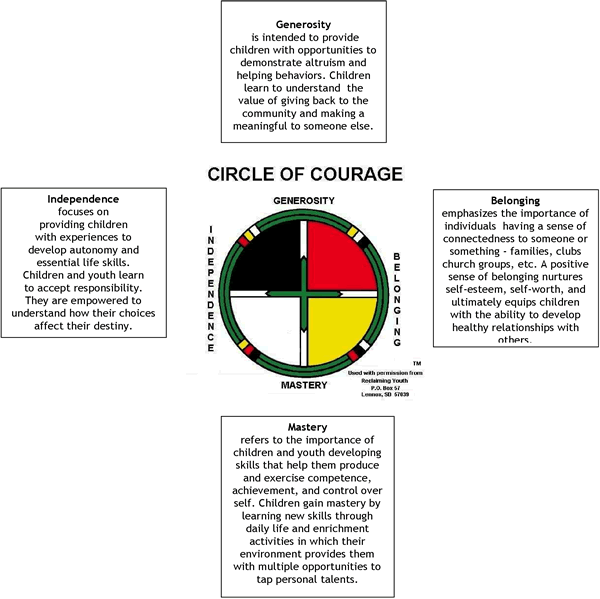
Circle of Courage Model
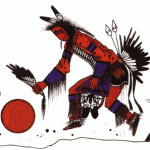
Maslow’s theory of human needs suggests that a sense of belonging must be attained before self-esteem and self-actualization can be realized. As children are drawn into the circle in the Spirit of Belonging, a relationship is established which is based upon mutual trust and respect. This provides the motivation to live with “a minimum of friction and maximum of goodwill” (Brendtro et al., 1990). The ultimate test of this kinship is behavior. You really belong when you act like you belong!
| Spirit of Belonging |
Distorted Spirit of Belonging |
Broken Spirit of Belonging |
| Attached |
Gang Loyalty |
Unattached |
| Loving |
Craves Affection |
Guarded |
| Friendly |
Craves Acceptance |
Rejected |
| Intimate |
Promiscuous |
Lonely |
| Gregarious |
Cult Vulnerable |
Isolated |
| Trusting |
Overly Dependent |
Distrustful |
Mending a Broken Spirit
- Create a cohesive classroom environment where each child can feel like an important member.
- Give positive encouragement.
- Recognize individuality and creative talents.
- Make sure teacher/caregiver expectations are very clear so children understand classroom expectations.
- Be specific when reinforcing a child’s positive behavior.
- With discipline and behavior, focus on the deed and not the doer.
Spirit of Mastery
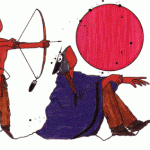
Native education strives to develop cognitive, physical, social and spiritual competence. This holistic view of learning recognizes that all students can learn and each student must be given the opportunity to demonstrate competence in all areas. Without opportunities for success, children will tend to express their frustration and lack of self-worth through inappropriate behaviors. Learning that is somehow connected to the everyday life of the child and the opportunities for sharing provide very powerful intrinsic motivators. In the Spirit of Mastery, success becomes “a possession of the many, not of the privileged few” (Brendtro et al., 1990).
| Spirit of Mastery |
Distorted Spirit of Mastery |
Broken Spirit of Mastery |
| Achiever |
Overachiever |
Non-achiever |
| Successful |
Arrogant |
Failure Oriented |
| Creative |
Risk Seeker |
Avoids Risks |
| Problem Solver |
Cheater |
Fears Challenges |
| Motivated |
Workaholic |
Unmotivated |
| Persistent |
Perseverative |
Gives Up Easily |
| Competent |
Delinquent Skill |
Inadequate |
Mending a Broken Spirit
- Connect classroom experiences with the children’s personal lives.
- Make sure each child experiences success in something.
- Help children set realistic goals.
- Teach problem solving strategies.
- Teach children to solve problems through collaboration.
- Encourage taking on challenging tasks.
- Consider alternative ways of knowing when designing activities.
Spirit of Independence
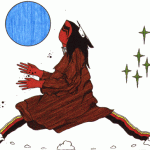
Native child rearing philosophies place great emphasis on “guidance without interference” (Brendtro et al., 1990). Learning then becomes the responsibility of the child who can be held accountable through appropriate learning opportunities. Child empowerment is required to foster the belief that a child is in control of the learning process. This sense of autonomy is a powerful intrinsic motivator. In Native American culture the internal locus of control must be balanced by social controls. Children first need to be dependent, learning to respect and value the wisdom of “elders”. Modeling provides a basic framework, which can be adjusted by each child to adapt to his/her particular learning style and multiple intelligences.
| Spirit of Independence |
Distorted Spirit of Independence |
Broken Spirit of Independence |
| Autonomous |
Dictatorial |
Submissive |
| Confident |
Reckless/Macho |
Lacks Confidence |
| Responsible |
Sexual Prowess |
Irresponsible |
| Inner Control |
Manipulative |
Helplessness |
| Self-Discipline |
Rebellious |
Undisciplined |
| Leadership |
Defies Authority |
Easily Led |
Mending a Broken Spirit
- Model decision-making and assist children in developing their own framework.
- Give choices for activities to recognize multiple intelligence development.
- Involve children in participatory decision-making.
- Encourage children how to engage as learners.
- Help children develop internal controls—an inner self-discipline for student empowerment.
- Teach alternative behaviors to improve personal control.
- Model and teach personal responsibility.
- Let children face the consequences of their behavior.
Spirit of Generosity
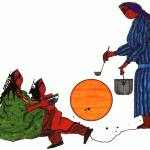
The highest virtues in Native culture are generosity and unselfishness. Self-esteem and self-worth are greatly increased by learning to help others. There is a responsibility to consider the welfare of everyone in the community. In a classroom or community site, peer tutoring and cooperative learning groups allow children to share their talents with others. There is a feeling of pride and joy that is experienced by helping others. Without opportunities to share their talents, students cannot become caring, responsible adults. The help given must be genuine and not equated with personal gain. Children should be encouraged to get involved in the community, and school, through a variety of service projects.
| Spirit of Generosity |
Distorted Spirit of Generosity |
Broken Spirit of Generosity |
| Altruistic |
Noblesse Oblige |
Selfish |
| Caring |
Over involved |
Affectionless |
| Sharing |
Plays Martyr |
Narcissistic |
| Loyal |
Co-dependency |
Disloyal |
| Empathic |
Over involvement |
Hardened |
| Pro-social |
Servitude |
Anti-social |
| Supportive |
Bondage |
Exploitative |
Mending a Broken Spirit
- Foster cooperative interpersonal relationships.
- Encourage child to be a good listener and a good communicator.
- Encourage children to express their opinions.
- Understand that children may express themselves in ways that may help or hurt themselves or others.
Reference:
Brendtro, L., Brokenleg, M., & Van Bockern, S. (1990). Reclaiming youth at risk: Our hope for the future. New Jersey: National Educational Services.




